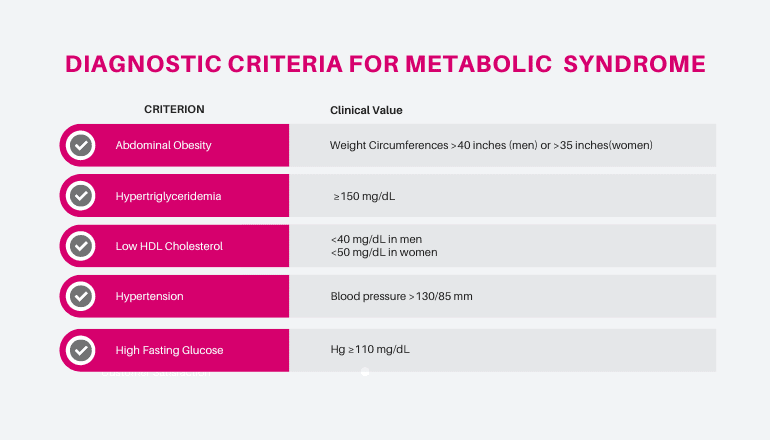Author: Dr.Jacob Neil (Specialist Internist – WELLKINS Medical Centre)
As we are going through a major pandemic of COVID-19 there is also another emerging Pandemic due to Lockdowns, Laziness and Junk food. The METABOLIC SYNDROME is on the rise in the community as a Non Communicable Disease.
What is Metabolic Syndrome?
In 2001, the National Cholesterol Education Program (NCEP) Adult Treatment Panel III (ATP III) proposed a simple set of diagnostic criteria based on common clinical measures including waist circumference, triglycerides, HDL-C, blood pressure, and fasting glucose level. The presence of abnormalities in any 3 of these 5 measures constitutes a diagnosis of Metabolic Syndrome.

What is the importance of early diagnosis of Metabolic Syndrome?
Metabolic syndrome is an indirect indicator that shows an increase in your chance of developing heart disease, stroke, and diabetes. The condition is also known by other names including Syndrome X, insulin resistance syndrome, and dysmetabolic syndrome. Early intervention will help in preventing future complications.
As we are going through a major pandemic of COVID-19 there is also another emerging Pandemic due to Lockdowns, Laziness and Junk food. The METABOLIC SYNDROME is on the rise in the community as a Non-Communicable Disease.
Who is prone to developing Metabolic Syndrome?
People who are having truncal obesity (increased fat in the abdomen/waist). Those with diabetes mellitus or a strong family history of diabetes mellitus or people with other clinical features of “insulin resistance” including skin changes of acanthosis nigricans (“darkened skin” on the back of the neck or underarms) or skin tags (usually on the neck. As you grow older, your risk of developing metabolic syndrome increases. Inactivity also can lead to metabolic syndrome.

How does this occur?
A combination of genetic and lifestyle factors may result in insulin resistance. Lifestyle factors include dietary habits, activity and perhaps interrupted sleep patterns (such as obstructive sleep apnea) can all contribute to the development of Metabolic Syndrome.
What are the possible symptoms?
Most of the symptoms would be related to excessive body weight, high blood pressure and symptoms related to high blood sugar like increased urination, excessive hunger and excessive thirst. Snoring could be an early indicator of underlying sleep apnea.
How do we diagnose Metabolic Syndrome?
Anthropometric assessment – Waist measurement
Blood pressure measurement
Laboratory Examination – Fasting Blood Sugar Level
Fasting Lipid Profile with emphasis on HDL and TGL values
What are the possible problems Metabolic Syndrome can lead to
Consistently high levels of insulin and glucose are linked to many harmful changes in the body
- Damage to the lining of coronary and other arteries can lead to the development of heart disease or stroke.
- Inability of the Kidneys to remove salt, leads to high blood pressure, heart disease, and stroke
- Increased triglyceride levels result in an increased risk of developing cardiovascular disease.
- A slowing of insulin production can signal the start of Type 2 Diabetes, Uncontrolled diabetes is associated with complications of the eyes, nerves, and kidneys.
- Fatty Liver, is sometimes associated with inflammation of the liver (non-alcoholic steatohepatitis, or NASH). If untreated, NASH could lead to cirrhosis and liver failure.
Treating Metabolic Syndrome :
Since physical inactivity and excess weight are the main underlying contributors to the development of metabolic syndrome, exercising, eating healthy and, if you are currently overweight or obese, attempting to lose weight can help reduce or prevent the complications associated with this condition. Your doctor may also prescribe medications to manage some aspects of your problems associated with metabolic syndrome. Some of the ways to reduce your risk:
- Healthy eating and attempting to lose weight if currently overweight or obese: Following a healthy diet and moderate weight loss, in the range of 5 percent to 10 percent of body weight, can help reduce Insulin Resistance, this can be done through diet, exercise, or even with help from weight-loss medications if recommended by your doctor.
- Exercise: Increased activity helps improve your insulin sensitivity. Aerobic exercise such as a brisk 30-minute daily walk can promote weight loss, improved blood pressure and triglycerides levels and a reduced risk of developing diabetes. A moderate activity of 150 mins a week is recommended.
- Dietary changes: Reduce Carbohydrate intake to no more than 50 percent of total calories. The source of carbohydrates should be whole grains (complex carbohydrates), such as whole grain bread (instead of white) and brown rice (instead of white). Whole grain products along with legumes (for example, beans), fruits and vegetables allow you to have a higher dietary fiber. Avoid red meat and consume poultry without skin and more fish. Consume healthy fats such as those in canola oil, olive oil, flaxseed oil and tree nuts.







